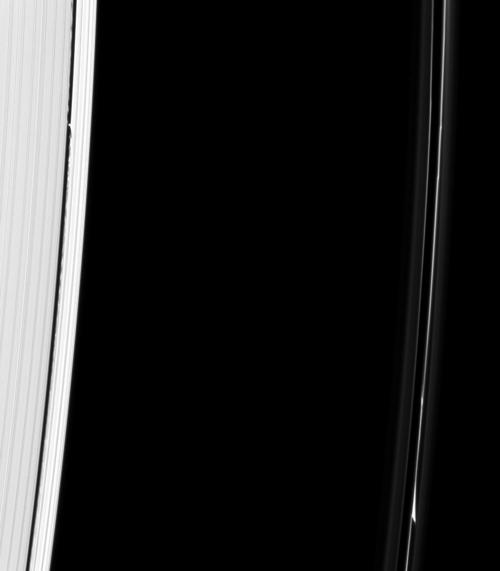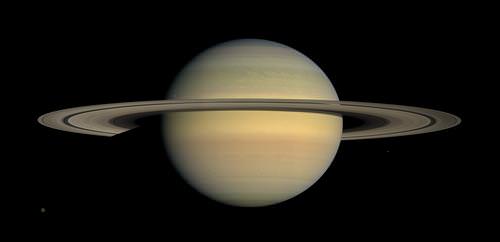[/caption]
The Cassini Equinox Mission released new images of Saturn, revealing stunning detail of the planet’s rings. As Saturn advances in its orbit toward equinox and the sun gradually moves northward on the planet, the motion of Saturn’s ring shadows and the changing colors of its atmosphere continue to transform the face of Saturn as seen by Cassini. While the Cassini spacecraft will always have good views of the rings, during 2009, Saturn’s rings will disappear from view on Earth. As Saturn approaches its equinox, the rings will be “on edge” from our vantage point, meaning that Saturn’s rings will appear thinner and thinner until on September 4th, 2009 the rings will seem to vanish! But don’t worry, they will reappear about three months later. But during that time, Cassini will track the changing light effects on the rings. Above, Cassini snapped a series of images during two hours in July that have been put together to create a full, natural color view of the planet, its rings, and six of its moons: Titan, Janus, Mimas, Pandora, Epimetheus and Enceladus. The image was taken over the course of approximately two hours as Cassini panned its wide-angle camera across the entire planet and ring system on July 23, 2008
But most impressive is a sweeping panorama of nearly the entire ring system, shown in natural color. See below!

Click to “embiggen” (stolen phrase from the Bad Astronomer) to get the full glory and splendor of Saturn’s rings!
This natural color mosaic, taken from 10 degrees below the illuminated side of the rings, shows, from left to right, radially outward from Saturn, the C ring (with its Colombo and Maxwell gaps); the B ring and the Cassini division beyond, with the intervening Huygens gap; the A ring (with its Encke and Keeler gaps); and, on the far right, the narrow F ring. The total span covers approximately 65,700 kilometers (40,800 miles).
The photograph is a combination of 45 images taken over the course of about 4 hours on Nov. 26.

The F ring and outer edge of the A ring can be seen in this image. A kink feature is visible in the F ring, probably caused by Prometheus or Pandora, the F ring’s shepherd moons.
Another moon, Daphnis, can be seen in the Keeler gap near the outer edge of the A ring, along with the waves Daphnis raises on that gap’s edges. Waves like these allow researchers to locate new moons in gaps and also estimate their masses.
The image was taken in visible light with the Cassini spacecraft narrow-angle camera on Nov. 7, 2008 at a distance of approximately 992,000 kilometers (616,000 miles) from Saturn and at a Sun-Saturn-spacecraft, or phase, angle of 48 degrees. Image scale is 6 kilometers (3 miles) per pixel.
And if you haven’t seen this one yet, this artwork was created by the Cassini Equinox Mission to wish everyone a happy holidays. Happy New Year from all of us here at Universe Today, too!
Source: Cassini



WOW! That is a fab picture of Saturn’s rings.
The Bad Astronomer stole “embiggen” from the Simpsons. In the episode “Lisa the Iconoclast” Jebediah Springfield, the founder of the town, is credited with saying “A noble spirit embiggens the smallest man.” (Of course, Lisa complains that “embiggen” isn’t a word.)
Fantastic picture of Saturn’s ring structure.
With four out of four of our solar system’s gas giants possessing ring structures, I would expect this to be true and common occurrence with very many star systems we discover that have giant exo-planets in orbit about them.
I wonder if ring structures would be limited to planets that lay beyond a certain distance from their host star or if with some of the giant exo-planets we have discovered so far that are very close to their host star could have ring structures as well. I would have my doubts that giant planets close to their parent star would have ring structures; I would doubt they would have as I think tidal forces from the parent star would prevent this.
Would this be a correct assumption?